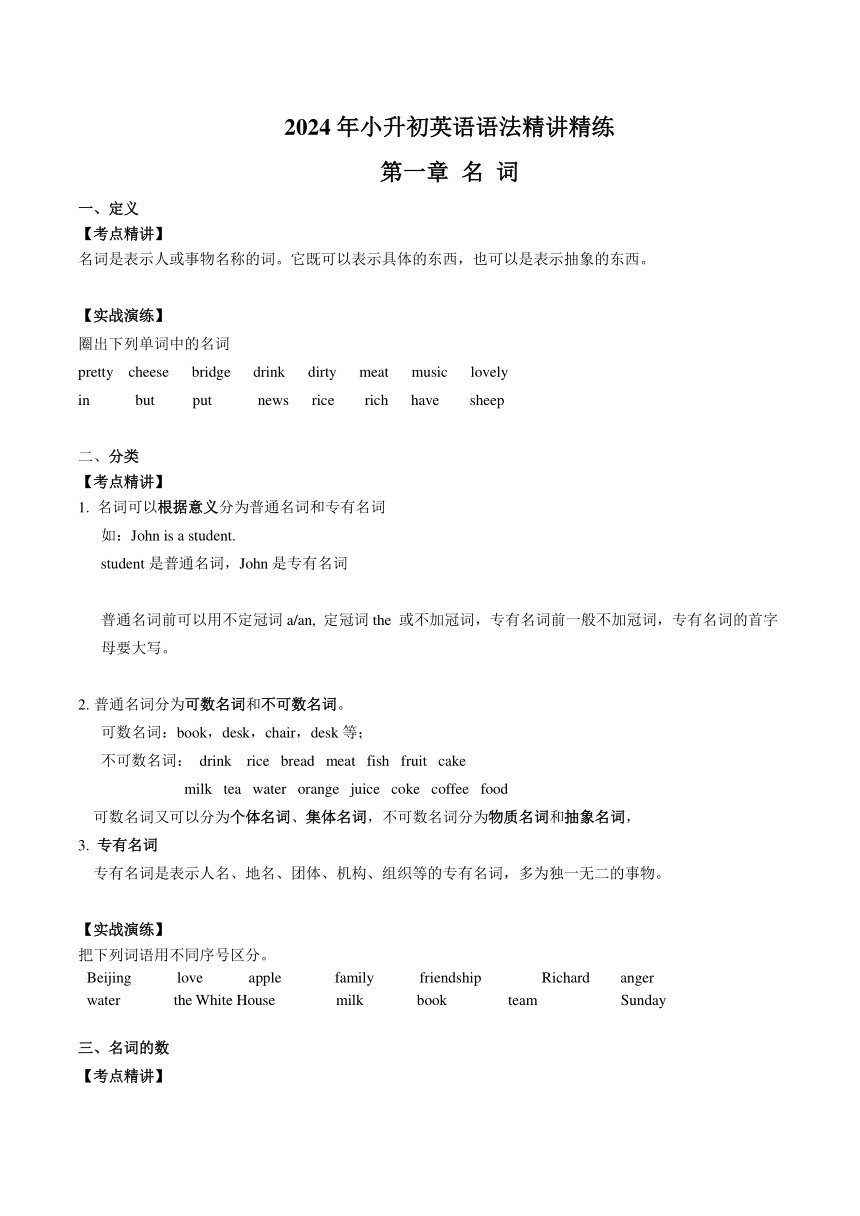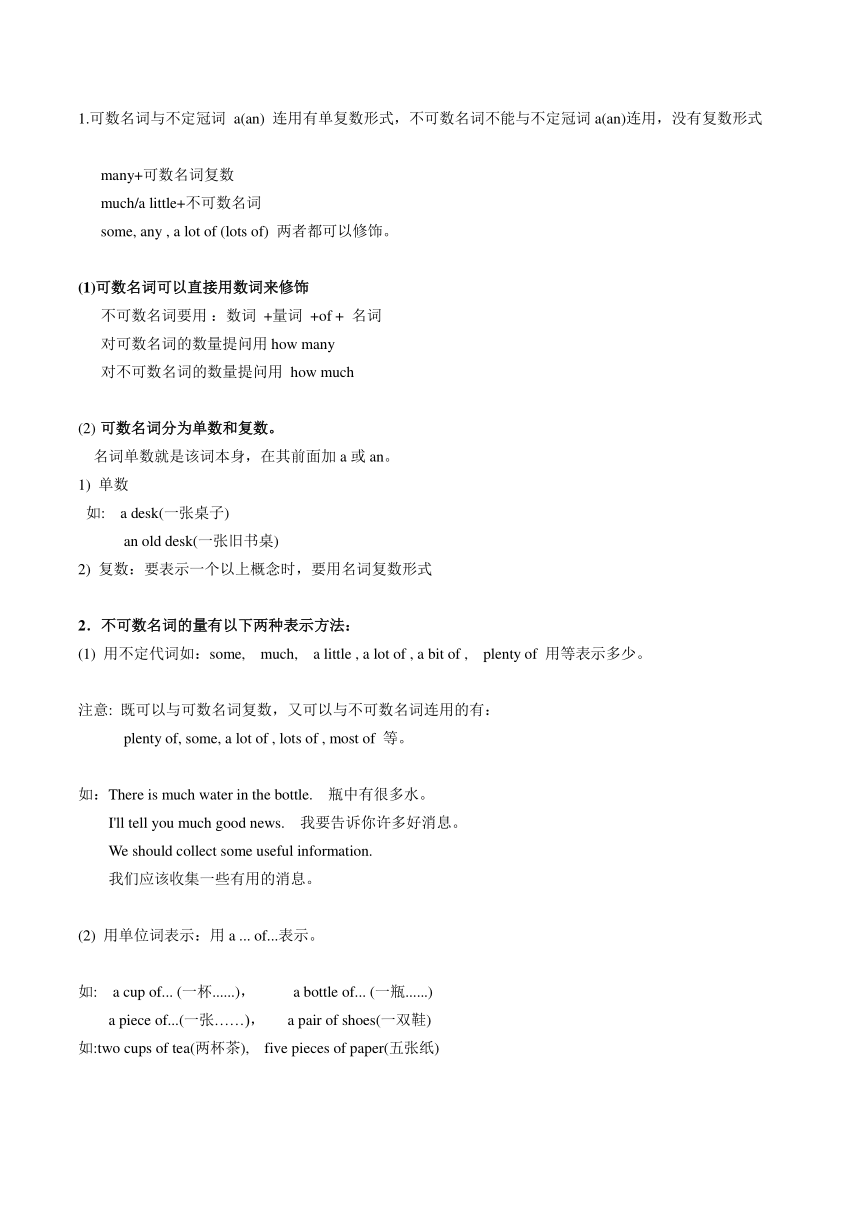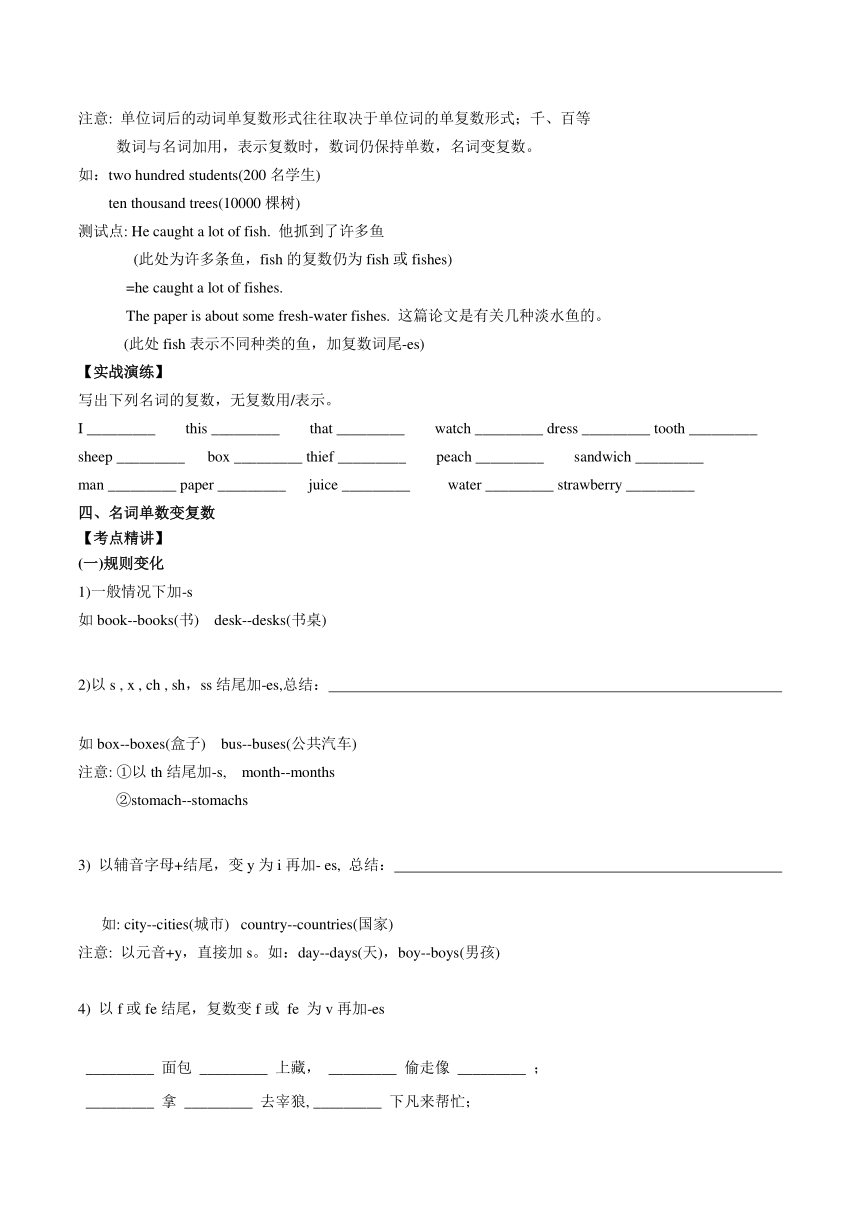人教PEP版英语六年级下册小升初英语语法精讲精练-名词学案(无答案)
文档属性
| 名称 | 人教PEP版英语六年级下册小升初英语语法精讲精练-名词学案(无答案) |  | |
| 格式 | docx | ||
| 文件大小 | 28.2KB | ||
| 资源类型 | 教案 | ||
| 版本资源 | 人教版(PEP) | ||
| 科目 | 英语 | ||
| 更新时间 | 2024-03-04 23:15:15 | ||
图片预览



文档简介
2024年小升初英语语法精讲精练
第一章 名 词
一、定义
【考点精讲】
名词是表示人或事物名称的词。它既可以表示具体的东西,也可以是表示抽象的东西。
【实战演练】
圈出下列单词中的名词
pretty cheese bridge drink dirty meat music lovely
in but put news rice rich have sheep
分类
【考点精讲】
1. 名词可以根据意义分为普通名词和专有名词
如:John is a student.
student是普通名词,John是专有名词
普通名词前可以用不定冠词a/an, 定冠词the 或不加冠词,专有名词前一般不加冠词,专有名词的首字母要大写。
普通名词分为可数名词和不可数名词。
可数名词:book,desk,chair,desk等;
不可数名词: drink rice bread meat fish fruit cake
milk tea water orange juice coke coffee food
可数名词又可以分为个体名词、集体名词,不可数名词分为物质名词和抽象名词,
3. 专有名词
专有名词是表示人名、地名、团体、机构、组织等的专有名词,多为独一无二的事物。
【实战演练】
把下列词语用不同序号区分。
Beijing love apple family friendship Richard anger
water the White House milk book team Sunday
名词的数
【考点精讲】
1.可数名词与不定冠词 a(an) 连用有单复数形式,不可数名词不能与不定冠词a(an)连用,没有复数形式
many+可数名词复数
much/a little+不可数名词
some, any , a lot of (lots of) 两者都可以修饰。
(1)可数名词可以直接用数词来修饰
不可数名词要用 :数词 +量词 +of + 名词
对可数名词的数量提问用how many
对不可数名词的数量提问用 how much
可数名词分为单数和复数。
名词单数就是该词本身,在其前面加a或an。
1) 单数
如: a desk(一张桌子)
an old desk(一张旧书桌)
2) 复数:要表示一个以上概念时,要用名词复数形式
2.不可数名词的量有以下两种表示方法:
(1) 用不定代词如:some, much, a little , a lot of , a bit of , plenty of 用等表示多少。
注意: 既可以与可数名词复数,又可以与不可数名词连用的有:
plenty of, some, a lot of , lots of , most of 等。
如:There is much water in the bottle. 瓶中有很多水。
I'll tell you much good news. 我要告诉你许多好消息。
We should collect some useful information.
我们应该收集一些有用的消息。
(2) 用单位词表示:用a ... of...表示。
如: a cup of... (一杯......), a bottle of... (一瓶......)
a piece of...(一张……), a pair of shoes(一双鞋)
如:two cups of tea(两杯茶), five pieces of paper(五张纸)
注意: 单位词后的动词单复数形式往往取决于单位词的单复数形式;千、百等
数词与名词加用,表示复数时,数词仍保持单数,名词变复数。
如:two hundred students(200名学生)
ten thousand trees(10000棵树)
测试点: He caught a lot of fish. 他抓到了许多鱼
(此处为许多条鱼,fish的复数仍为fish或fishes)
=he caught a lot of fishes.
The paper is about some fresh-water fishes. 这篇论文是有关几种淡水鱼的。
(此处fish表示不同种类的鱼,加复数词尾-es)
【实战演练】
写出下列名词的复数,无复数用/表示。
I _________ this _________ that _________ watch _________ dress _________ tooth _________ sheep _________ box _________ thief _________ peach _________ sandwich _________
man _________ paper _________ juice _________ water _________ strawberry _________
名词单数变复数
【考点精讲】
(一)规则变化
1)一般情况下加-s
如book--books(书) desk--desks(书桌)
2)以s , x , ch , sh,ss结尾加-es,总结:
如box--boxes(盒子) bus--buses(公共汽车)
注意: ①以th结尾加-s, month--months
②stomach--stomachs
3) 以辅音字母+结尾,变y为i再加- es, 总结:
如: city--cities(城市) country--countries(国家)
注意: 以元音+y,直接加s。如:day--days(天),boy--boys(男孩)
4) 以f或fe结尾,复数变f或 fe 为v再加-es
_________ 面包 _________ 上藏, _________ 偷走像 _________ ;
_________ 拿 _________ 去宰狼, _________ 下凡来帮忙;
小偷慌忙保 _________ _________ , _________ 片 _________ 遮目光。
wife(妻子),knife(刀子),wolf(狼)thief(小偷),shelf(架子),
life(生命)leaf(树叶),self(自己),half(一半),
如: knife-knives(书) , half-halves(一半)
(thief ,wife ,life ,shelf ,knife ,leaf ,self ,half ,wolf)
注意:①有少数词后直接加s,如roof-roofs (屋顶)
5) 以o结尾,总结:
(1)加-es ,如:
tomato-tomatoes (西红杮)
potato-potatoes (土豆)
(2)加-s,如:
piano-pianos (钢琴), zoo-zoos (动物园)
photo-photos (照片), kangaroo-kangaroos (袋鼠)
kilo-kilos (千克)
(3) 注意:zero 两种方式都可:zero-zeros或 zeroes(零)
(二)不规则变化
(1)a变成e,总结:
例如:man-men , woman-women,
milkman-milkmen , postman-postmen
但是,特殊的,German-Germans(德国人)
(2) oo变成ee,总结:
例如:foot-feet , tooth-teeth , goose-geese
(3)单复数同形,总结:
sheep-sheep , deer-deer , fish-fish
(4) 不规则中的不规则,总结:
child-children , ox-oxen , mouse-mice
(5) 集体名词,形似单数,实为复数意义。
如:people(人,人们) these people (不说a people,可说a person)
police(公安,警察) ten police (不说a police,可说a policeman)
(6) 由man和woman构成的合成名词,变复数将名词及man或woman都变成复数。 总结:
如: a man driver-men drivers (男司机)
a woman doctor-women doctors (女医生)
但是,其他名词,比如:以boy和girl开头的复合名词变成复数时,一般只把后一名词变成复数。
如: boy student - boy students (男学生)
girlfriend - girlfriends (女朋友)
合成名词变为复数时,通常只将里面所含的主体名词变为复数。
总结:
如: bus driver - bus drivers(汽车司机)
注意:如果没有主体名词,就在最后一个词上加-s。如:
grown-up - grown-ups(成年人)
letter-box - letter-boxes (信箱)
(8)有些名词只有作复数,总结:
如: scissors(剪刀) a pair of scissors(一把剪刀)
trousers(裤子) shorts(短裤) jeans(工装裤)
sunglasses(太阳镜) writings(作品)
(9)国家人单复数变化,总结:
A: Chinese — _________ Japanese — _________
Swedish — _________ Dutch — _________
B: American— _________ Canadian— _________
C: Englishman— _________ Frenchman— _________
German— _________
【实战演练】
填入适当的词。
I have two _________ .(knife)
There are many _________ here. (box)
There are many _________ on the road. (bus)
A few _________ are drawing on the wall. (boy)
The _________ are playing football now. (child)
五、名词的所有格
【考点精讲】
总结:
对有生命的名词,在名词后加上 _________ 或 _________ 来表示;
A:单数名词
a:直接加 _________ ;如: Mary's father (玛丽的父亲)
Jim's mother (吉姆的母亲)
b:对以s结尾的单数名词,常加 _________ ;
如:the boss _________ handwriting
c:对以s结尾的人名,加 _________ ;如:Hans _________ car
B:复数名词
a:复数名词以s结尾,直接加 _________ ;如:the boys _________ school
Teachers _________ Day
b:复数没有以s结尾的,直接加 _________ ;Children _________ Day
无生命名词的所有格通常只能用 _________ + _________ + _________ 的结构来替代’s结构:
(这面墙的颜色)
(学校的老师们)
(3)无生命名词表示物品,即关系时,常用 _________ 替代 _________ 来表示所有格,即 _________ + _________ + _________ 结构;
(门的钥匙)
(问题的答案)
(4)无生命名词中,表示 _________ 和 _________ 和 _________ 和 _________ 仍用 _________ 表示所有格;
(今天的报纸)
(10分钟的走路路程)
(中国的明天)
(城市的花园)
如表示共同所有时,在 _________ 名词上加’或’s;
如表示各自所有时,则在 _________ 名词上加’或’s;
如:This _________ Jim and Mike's room.吉姆和麦克(共用)的房间
These _________ Jim's and Mike's rooms.吉姆和麦克(各自)的房间
【实战演练】
用所给词的适当形式填空:
March 8th is _________ Day. (woman)
Taking twenty _________ (分钟) exercise every day is good for your health.
The shop sells _________ (妇女) handbags.
I’ll give my English teacher a card for _________ Day. (teacher)
It’s only ten _________ walk from the station to the hotel. (minute)
It’s an __________(hour) ride from here to the museum.
第一章 名 词
一、定义
【考点精讲】
名词是表示人或事物名称的词。它既可以表示具体的东西,也可以是表示抽象的东西。
【实战演练】
圈出下列单词中的名词
pretty cheese bridge drink dirty meat music lovely
in but put news rice rich have sheep
分类
【考点精讲】
1. 名词可以根据意义分为普通名词和专有名词
如:John is a student.
student是普通名词,John是专有名词
普通名词前可以用不定冠词a/an, 定冠词the 或不加冠词,专有名词前一般不加冠词,专有名词的首字母要大写。
普通名词分为可数名词和不可数名词。
可数名词:book,desk,chair,desk等;
不可数名词: drink rice bread meat fish fruit cake
milk tea water orange juice coke coffee food
可数名词又可以分为个体名词、集体名词,不可数名词分为物质名词和抽象名词,
3. 专有名词
专有名词是表示人名、地名、团体、机构、组织等的专有名词,多为独一无二的事物。
【实战演练】
把下列词语用不同序号区分。
Beijing love apple family friendship Richard anger
water the White House milk book team Sunday
名词的数
【考点精讲】
1.可数名词与不定冠词 a(an) 连用有单复数形式,不可数名词不能与不定冠词a(an)连用,没有复数形式
many+可数名词复数
much/a little+不可数名词
some, any , a lot of (lots of) 两者都可以修饰。
(1)可数名词可以直接用数词来修饰
不可数名词要用 :数词 +量词 +of + 名词
对可数名词的数量提问用how many
对不可数名词的数量提问用 how much
可数名词分为单数和复数。
名词单数就是该词本身,在其前面加a或an。
1) 单数
如: a desk(一张桌子)
an old desk(一张旧书桌)
2) 复数:要表示一个以上概念时,要用名词复数形式
2.不可数名词的量有以下两种表示方法:
(1) 用不定代词如:some, much, a little , a lot of , a bit of , plenty of 用等表示多少。
注意: 既可以与可数名词复数,又可以与不可数名词连用的有:
plenty of, some, a lot of , lots of , most of 等。
如:There is much water in the bottle. 瓶中有很多水。
I'll tell you much good news. 我要告诉你许多好消息。
We should collect some useful information.
我们应该收集一些有用的消息。
(2) 用单位词表示:用a ... of...表示。
如: a cup of... (一杯......), a bottle of... (一瓶......)
a piece of...(一张……), a pair of shoes(一双鞋)
如:two cups of tea(两杯茶), five pieces of paper(五张纸)
注意: 单位词后的动词单复数形式往往取决于单位词的单复数形式;千、百等
数词与名词加用,表示复数时,数词仍保持单数,名词变复数。
如:two hundred students(200名学生)
ten thousand trees(10000棵树)
测试点: He caught a lot of fish. 他抓到了许多鱼
(此处为许多条鱼,fish的复数仍为fish或fishes)
=he caught a lot of fishes.
The paper is about some fresh-water fishes. 这篇论文是有关几种淡水鱼的。
(此处fish表示不同种类的鱼,加复数词尾-es)
【实战演练】
写出下列名词的复数,无复数用/表示。
I _________ this _________ that _________ watch _________ dress _________ tooth _________ sheep _________ box _________ thief _________ peach _________ sandwich _________
man _________ paper _________ juice _________ water _________ strawberry _________
名词单数变复数
【考点精讲】
(一)规则变化
1)一般情况下加-s
如book--books(书) desk--desks(书桌)
2)以s , x , ch , sh,ss结尾加-es,总结:
如box--boxes(盒子) bus--buses(公共汽车)
注意: ①以th结尾加-s, month--months
②stomach--stomachs
3) 以辅音字母+结尾,变y为i再加- es, 总结:
如: city--cities(城市) country--countries(国家)
注意: 以元音+y,直接加s。如:day--days(天),boy--boys(男孩)
4) 以f或fe结尾,复数变f或 fe 为v再加-es
_________ 面包 _________ 上藏, _________ 偷走像 _________ ;
_________ 拿 _________ 去宰狼, _________ 下凡来帮忙;
小偷慌忙保 _________ _________ , _________ 片 _________ 遮目光。
wife(妻子),knife(刀子),wolf(狼)thief(小偷),shelf(架子),
life(生命)leaf(树叶),self(自己),half(一半),
如: knife-knives(书) , half-halves(一半)
(thief ,wife ,life ,shelf ,knife ,leaf ,self ,half ,wolf)
注意:①有少数词后直接加s,如roof-roofs (屋顶)
5) 以o结尾,总结:
(1)加-es ,如:
tomato-tomatoes (西红杮)
potato-potatoes (土豆)
(2)加-s,如:
piano-pianos (钢琴), zoo-zoos (动物园)
photo-photos (照片), kangaroo-kangaroos (袋鼠)
kilo-kilos (千克)
(3) 注意:zero 两种方式都可:zero-zeros或 zeroes(零)
(二)不规则变化
(1)a变成e,总结:
例如:man-men , woman-women,
milkman-milkmen , postman-postmen
但是,特殊的,German-Germans(德国人)
(2) oo变成ee,总结:
例如:foot-feet , tooth-teeth , goose-geese
(3)单复数同形,总结:
sheep-sheep , deer-deer , fish-fish
(4) 不规则中的不规则,总结:
child-children , ox-oxen , mouse-mice
(5) 集体名词,形似单数,实为复数意义。
如:people(人,人们) these people (不说a people,可说a person)
police(公安,警察) ten police (不说a police,可说a policeman)
(6) 由man和woman构成的合成名词,变复数将名词及man或woman都变成复数。 总结:
如: a man driver-men drivers (男司机)
a woman doctor-women doctors (女医生)
但是,其他名词,比如:以boy和girl开头的复合名词变成复数时,一般只把后一名词变成复数。
如: boy student - boy students (男学生)
girlfriend - girlfriends (女朋友)
合成名词变为复数时,通常只将里面所含的主体名词变为复数。
总结:
如: bus driver - bus drivers(汽车司机)
注意:如果没有主体名词,就在最后一个词上加-s。如:
grown-up - grown-ups(成年人)
letter-box - letter-boxes (信箱)
(8)有些名词只有作复数,总结:
如: scissors(剪刀) a pair of scissors(一把剪刀)
trousers(裤子) shorts(短裤) jeans(工装裤)
sunglasses(太阳镜) writings(作品)
(9)国家人单复数变化,总结:
A: Chinese — _________ Japanese — _________
Swedish — _________ Dutch — _________
B: American— _________ Canadian— _________
C: Englishman— _________ Frenchman— _________
German— _________
【实战演练】
填入适当的词。
I have two _________ .(knife)
There are many _________ here. (box)
There are many _________ on the road. (bus)
A few _________ are drawing on the wall. (boy)
The _________ are playing football now. (child)
五、名词的所有格
【考点精讲】
总结:
对有生命的名词,在名词后加上 _________ 或 _________ 来表示;
A:单数名词
a:直接加 _________ ;如: Mary's father (玛丽的父亲)
Jim's mother (吉姆的母亲)
b:对以s结尾的单数名词,常加 _________ ;
如:the boss _________ handwriting
c:对以s结尾的人名,加 _________ ;如:Hans _________ car
B:复数名词
a:复数名词以s结尾,直接加 _________ ;如:the boys _________ school
Teachers _________ Day
b:复数没有以s结尾的,直接加 _________ ;Children _________ Day
无生命名词的所有格通常只能用 _________ + _________ + _________ 的结构来替代’s结构:
(这面墙的颜色)
(学校的老师们)
(3)无生命名词表示物品,即关系时,常用 _________ 替代 _________ 来表示所有格,即 _________ + _________ + _________ 结构;
(门的钥匙)
(问题的答案)
(4)无生命名词中,表示 _________ 和 _________ 和 _________ 和 _________ 仍用 _________ 表示所有格;
(今天的报纸)
(10分钟的走路路程)
(中国的明天)
(城市的花园)
如表示共同所有时,在 _________ 名词上加’或’s;
如表示各自所有时,则在 _________ 名词上加’或’s;
如:This _________ Jim and Mike's room.吉姆和麦克(共用)的房间
These _________ Jim's and Mike's rooms.吉姆和麦克(各自)的房间
【实战演练】
用所给词的适当形式填空:
March 8th is _________ Day. (woman)
Taking twenty _________ (分钟) exercise every day is good for your health.
The shop sells _________ (妇女) handbags.
I’ll give my English teacher a card for _________ Day. (teacher)
It’s only ten _________ walk from the station to the hotel. (minute)
It’s an __________(hour) ride from here to the museum.
